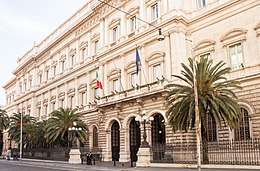Bank of Italy
The Bank of Italy, known in Italian as [La] Banca d'Italia (pronounced [ˈbaŋka diˈtaːlja]), also known as Bankitalia, is the central bank of Italy and part of the European System of Central Banks. It is located in Palazzo Koch, via Nazionale, Rome. The bank's current governor is Ignazio Visco, who took the office on 1 November 2011.
 | |
| Headquarters | Palazzo Koch, Rome, Italy |
|---|---|
| Established | 1893 |
| Ownership | Banks, insurance companies and social security institutions[1] |
| Governor | Ignazio Visco |
| Central bank of | Italy |
| Reserves | 34 440 million USD[1] |
| Succeeded by | European Central Bank (1999)1 |
| Website | Official website |
| 1 The Bank of Italy still exists but many functions have been taken over by the ECB. | |

Functions
After the charge of monetary and exchange rate policies was shifted in 1998 to the European Central Bank, within the European institutional framework, the bank implements the decisions, issues euro banknotes and withdraws and destroys worn pieces.
The main function has thus become banking and financial supervision. The objective is to ensure the stability and efficiency of the system and compliance to rules and regulations; the bank pursues it through secondary legislation, controls and cooperation with governmental authorities.
Following reform in 2005, which was prompted by takeover scandals, the bank has lost exclusive antitrust authority in the credit sector, which is now shared with the Italian Competition Authority (Italian: Autorità Garante della Concorrenza e del Mercato).
Other functions include market supervision, oversight of the payment system and provision of settlement services, State treasury service, Central Credit Register, economic analysis and institutional consultancy.
As of 2017, the Bank of Italy owned 2,451.8 tonnes of gold, the third-largest gold reserve in the world.[2]
History
The institution was established in 1893 from the combination of three major banks in Italy (after the Banca Romana scandal).[3][4] The new central bank first issued bank-notes during 1926.[5] Until 1928, it was directed by a general manager, after this time instead by a governor elected by an internal commission of managers, with a decree from the President of the Italian Republic, for a term of seven years.
Directors general (1893–1928)
- Giacomo Grillo (1893–1894)
- Giuseppe Marchiori (1894–1900)
- Bonaldo Stringher (1900–1928)
Governors (1928–present)
- Bonaldo Stringher (1928–1930)
- Vincenzo Azzolini (1931–1944)
- Luigi Einaudi (1945–1948)
- Donato Menichella (1948–1960)
- Guido Carli (1960–1975)
- Paolo Baffi (1975–1979)
- Carlo Azeglio Ciampi (1979–1993)
- Antonio Fazio (1993–2005)
- Mario Draghi (2005–2011)
- Ignazio Visco (2011–present)
Organization
Governing bodies
The bank's governing bodies are the General Meeting of Shareholders, the board of directors, the governor, the director general and three deputy directors general; the last five constitute the directorate.
The general meeting takes place yearly and with the purpose of approving accounts and appointing the auditors. The board of directors has administrative powers and is chaired by the governor (or by the director general in his absence). Following reform in 2005, the governor lost exclusive responsibility regarding decisions of external relevance (i.e. banking and financial supervision), which has been transferred to the directorate (by majority vote). The director general is responsible for the day-to-day administration of the bank, and acts as governor when absent.
The board of auditors assesses the bank's administration and compliance with the law, regulations and the statute.
Appointment
The directorate's term of office lasts six years and is renewable once. The appointment of the governor is the responsibility of the government, head of the board of directors, with the approval of the president (formally a decree of the president). The board of directors is elected by the shareholders according to the bank statute.
On 25 October 2011, Silvio Berlusconi nominated Ignazio Visco to be the bank's new governor to replace Mario Draghi when he left to become president of the European Central Bank in November.[6]
Shareholders
Banca d'Italia had 300,000 shares with a nominal value of €25,000. Originally scattered around the banks of whole Italy, the shares now accumulated due to the merger of the banks since 1990s. The status of the bank states that a minimum of 54% of profits would go to the Italian government, and only a maximum of 6% of profits would distributed as dividends according to shares ratio.[7]
- As of 1 December 2016[8]
| Number of shares | Percentage | Voting rights | Percentage | |
|---|---|---|---|---|
| Intesa Sanpaolo | 76,787 | 25.60% | ||
| — Cassa di Risparmio in Bologna (subsidiary) | 18,602 | 6.20% | ||
| — Cassa di Risparmio di Firenze (subsidiary) | 5,656 | 1.89% | ||
| — Cassa di Risparmio del Veneto (subsidiary) | 3,610 | 1.20% | ||
| — Cassa di Risparmio del Friuli Venezia Giulia (subsidiary) | 1,869 | 0.62% | ||
| — Cassa di Risparmio di Pistoia e della Lucchesia (subsidiary) | 1,126 | 0.38% | ||
| — Casse di Risparmio dell'Umbria (subsidiary) | 1,106 | 0.37% | ||
| — Banca dell'Adriatico (subsidiary) | 653 | 0.22% | ||
| — Cassa dei Risparmi di Forlì e della Romagna (subsidiary) | 605 | 0.20% | ||
| UniCredit | 56,049 | 18.68% | ||
| Italian Ministry of Labour and Social Policy | 0 | 0.00% | 0 | 0.00% |
| — INPS | 9,000 | 3.00% | ||
| — Cassa Forense | 9,000 | 3.00% | ||
| — INARCASSA | 9,000 | 3.00% | ||
| — Fondazione ENPAM | 9,000 | 3.00% | ||
| — INAIL | 8,000 | 2.67% | ||
| — Fondazione ENPAIA | 3,000 | 1.00% | ||
| — CNPR | 1,500 | 0.50% | ||
| Generali Italia | 16,425 | 5.48% | ||
| Cassa di Risparmio di Genova e Imperia | 12,093 | 4.03% | ||
| — Banca del Monte di Lucca (subsidiary) | 2 | 0.00% | ||
| Cassa di Risparmio di Asti | 2,800 | 0.93% | ||
| — Cassa di Risparmio di Biella e Vercelli (subsidiary) | 6,300 | 2.10% | ||
| BNP Paribas | 0 | 0.00% | 0 | 0.00% |
| — Banca Nazionale del Lavoro (subsidiary) | 8,500 | 2.83% | ||
| Banca Monte dei Paschi di Siena | 7,500 | 2.50% | ||
| Crédit Agricole | 0 | 0.00% | 0 | 0.00% |
| — Cassa di Risparmio di Parma e Piacenza (subsidiary) | 6,094 | 2.03% | ||
| — Cassa di Risparmio della Spezia (subsidiary) | 266 | 0.09% | ||
| UnipolSai Assicurazioni | 6,000 | 2.00% | ||
| Banco Popolare | 3,668 | 1.22% | ||
| Nuova Banca delle Marche | 2,459 | 0.82% | ||
| — Cassa di Risparmio di Loreto (subsidiary) | 100 | 0.03% | ||
| Unione di Banche Italiane | 0 | 0.00% | 0 | 0.00% |
| — Banca Regionale Europea (subsidiary) | 759 | 0.25% | ||
| — Banca Carime (subsidiary) | 500 | 0.17% | ||
| Nuova Cassa di Risparmio di Ferrara | 949 | 0.32% | ||
| Banca Popolare di Milano | 873 | 0.29% | ||
| Cassa di Risparmio di Ravenna | 769 | 0.26% | ||
| Banca Popolare dell'Emilia Romagna | 759 | 0.25% | ||
| Cassa di Risparmio di Fossano | 750 | 0.25% | ||
| Banca Popolare di Vicenza | 687 | 0.23% | ||
| Cassa di Risparmio di Cesena | 675 | 0.23% | ||
| Cassa di Risparmio di San Miniato | 652 | 0.22% | ||
| Fondazione Cassa di Risparmio di Carpi | 600 | 0.20% | ||
| Reale Mutua di Assicurazioni | 500 | 0.17% | ||
| Veneto Banca | 480 | 0.16% | ||
| Eurovita Assicurazioni | 400 | 0.13% | ||
| Fondazione Cassa di Risparmio di Perugia | 400 | 0.13% | ||
| Cassa di Risparmio di Rimini | 393 | 0.13% | ||
| Südtiroler Sparkasse – Cassa di Risparmio di Bolzano | 377 | 0.13% | ||
| Banca Popolare di Bari | 0 | 0.00% | 0 | 0.00% |
| — Cassa di Risparmio di Orvieto (subsidiary) | 237 | 0.08% | ||
| — Cassa di Risparmio della Provincia di Teramo (subsidiary) | 115 | 0.04% | ||
| — Cassa di Risparmio di Pescara e di Loreto Aprutino (subsidiary) | 8 | 0.00% | ||
| Cassa di Risparmio di Cento | 311 | 0.10% | ||
| Fondazione Manodori | 300 | 0.10% | ||
| Banca Cassa di Risparmio di Savigliano | 200 | 0.07% | ||
| Allianz S.p.A. | 200 | 0.07% | ||
| BCC Roma | 200 | 0.07% | ||
| Banca Sistema | 200 | 0.07% | ||
| Banca del Piemonte | 200 | 0.07% | ||
| Cassa di Risparmio di Volterra | 194 | 0.06% | ||
| Nuova Cassa di Risparmio di Chieti | 151 | 0.05% | ||
| Cassa di Risparmio di Fermo | 130 | 0.04% | ||
| Banca Sella Holding | 120 | 0.04% | ||
| Credito Valtellinese | 101 | 0.03% | ||
| Cassa di Risparmio della Repubblica di San Marino | 36 | 0.01% | ||
| Cassa di Risparmio di Saluzzo | 4 | 0.00% | ||
See also
References
- https://d-nb.info/1138787981/34
- "Latest Gold Holdings – XLSX Download – World Gold Council". www.gold.org.
- Alfredo Gigliobianco and Claire Giordano, "Economic Theory and Banking Regulation: The Italian Case (1861-1930s)", Quaderni di Storia Economica (Economic History Working Papers), No. 5, November 2010
- "Banca D'Italia: Origins", Banca D'Italia.
- "Banca D'Italia: History", Banca D'Italia.
- "Berlusconi names Visco to head Bank of Italy in surprise move". Reuters. 20 October 2011. Retrieved 11 February 2018.
- "Status", Banca d'Italia.
- https://www.bancaditalia.it/chi-siamo/funzioni-governance/partecipanti-capitale/shareholders-011216.pdf?language_id=1
